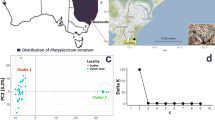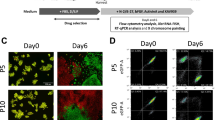Summary
In the varying lemming, only some of the females exhibit a conventional sex chromosome constitution, XX. Many fertile females as well as all males have one X chromosome. The Y chromosome was not revealed by the methods employed. It has been shown that the sex of XO specimens depends on a genetic factor which displays two alternative forms. The XO lemmings possessing the m-form develop as males; those carrying the f-form develop as females. This factor is most likely X-linked. The XX females are heterozygous for this factor or homozygous for the m-form. In progeny of the XO and heterozygous XX females an excess of daughters is observed, the secondary sex ratio being 0·67 and 0·75 respectively. Two or three mutational events must have given rise to this complex system of sex determination. The possible adaptive significance of the relevant system is discussed.
Similar content being viewed by others
Article PDF
References
Benenson, I E. 1978. Investigation of secondary sex ratio in laboratory colonies of certain rodents. Proceedings of Institute of Plant and Animal Ecology, Sverdlovsk, 7–8 (in Russian).
Bjersing, L. 1977. H-Y antigens and sexual differentiation. Lancet, N8006, 311.
Cattanach, B M. 1974. Genetic disorders of sex determination in mice and other mammals. In: Birth Defects. Proceedings of the Fourth International Conference, Vienna, 1973, 129–141.
Cattanach, B M, Pollard, C E, and Hawkes, S G. 1971. Sex-reversed mice: XX and XO males. Cytogenetics, 10, 318–337.
Chernyavsky, F B. 1978. Population cycles of Siberian and varying lemmings on Wrangel island. Transactions of the Second Congress of the Theriological Society of the USSR, Moscow, 210–212 (in Russian).
Evans, E P, Breckon, G, and Ford, C E. 1964. An air-drying method for meiotic preparations from mammalian testes. Cytogenetics, 3, 289–294.
Fredga, K. 1971. Unusual sex chromosome inheritance in mammals. Philosophical Transactions of the Royal Society of London, 259B, 15–36.
Fredga, K, Gropp, A, Winking, H, and Frank, F. 1976. Fertile XX-and XY-type females in the wood lemming, Myopus schisticolor. Nature, 261, 225–228.
Fredga, K, Gropp, A, Winking, H, and Frank, F. 1977. A hypothesis explaining the exceptional sex ratio in the wood lemming (Myopus schisticolor). Hereditas, 85, 101–104.
Gileva, E A. 1973. B-chromosomes, unusual inheritance of sex chromosomes and sex ratio in the varying lemming, Dicrostonyx torquatus torquatus Pall. (1779). Proceedings of the Academy of Sciences of the USSR, 213, 952–955 (in Russian).
Gileva, E A. 1975. Karyotype of Dicrostonyx torquatus chionopaes Allen and unusual chromosomal mechanism of sex determination in Palaearctic varying lemmings. Proceedings of the Academy of Sciences of the USSR, 224, 697–700 (in Russian).
Lyon, M F, and Hawkes, S G. 1970. X-linked gene for testicular feminization in the mouse. Nature, 227, 1217–1219.
Ma, N S F, Elliott, M W, Morgan, L, Miller, A, and Jones, T C. 1976. Translocation of Y chromosome to an autosome in the Bolivian owl monkey, Aotus. American Journal of Physical Anthropology, 45, 191–201.
De La Maza, L M, and Sawyer, J R. 1976. The G and Q banding pattern of Ellobius lutescens. A unique case of sex determination in mammals. Canadian Journal of Genetics and Cytology, 18, 497–502.
Mittwoch, U. 1973. Genetics of sex differentiation. Academic Press, New York—London.
Ohno, S. 1967. Sex chromosomes and sex-linked genes. Springer, Berlin—Heidelberg—New York.
Seabright, M. 1972. The use of proteolytic enzymes for the mapping of structural rearrangements in the chromosomes in man. Chromosoma, 36, 204–210.
Soller, M, Padeh, B, Wysoki, M, and Ayalon, N. 1969. Cytogenetics of Saanen goats showing abnormal development of the reproductive tract associated with the dominant gene for polledness. Cytogenetics, 8, 51–67.
Sternberg, W H, Barclay, D L, and Kloepfer, H W. 1968. Familial XY gonadal dysgenesis. New England Journal of Medicine, 278, 695–700.
Tarkovsky, A K. 1966. An air-drying method for chromosome preparations from mouse eggs. Cytogenetics, 5, 394–400.
Wachtel, S S. 1977. H-Y antigen: genetics and serology. Immunological Reviews, 33, 33–58.
Wachtel, S S, Koo, G C, Breg, W R, Thaler, H T, Dillard, G M, Rosenthal, I M, Dosik, H, Gerald, P S, Saenger, P, New, M, Lieber, E, and Miller, O J. 1976. Serologic detection of a Y-linked gene in XX males and XX true hermaphrodites. New England Journal of Medicine, 295, 750–754.
Author information
Authors and Affiliations
Rights and permissions
About this article
Cite this article
Gileva, E., Chebotar, N. Fertile XO males and females in the varying lemming, Dicrostonyx torquatus pall. (1779). Heredity 42, 67–77 (1979). https://doi.org/10.1038/hdy.1979.7
Received:
Issue date:
DOI: https://doi.org/10.1038/hdy.1979.7
This article is cited by
-
Genome-wide comparative chromosome maps of Arvicola amphibius, Dicrostonyx torquatus, and Myodes rutilus
Chromosome Research (2016)
-
The role of genetic factors in human radioresistance
Russian Journal of Genetics (2005)
-
The B chromosome system in the varying lemming Dicrostonyx torquatus Pall., 1779 from natural and laboratory populations
Russian Journal of Genetics (2004)
-
Sex ratio, XY females and absence of inbreeding in a population of the Wood Lemming, Myopus schisticolor Lilljeborg, 1844
Heredity (1991)
-
Meiotic drive in the sex chromosome system of the varying lemming, Dicrostonyx torquatus Pall. (Rodentia, Microtinae)
Heredity (1987)



